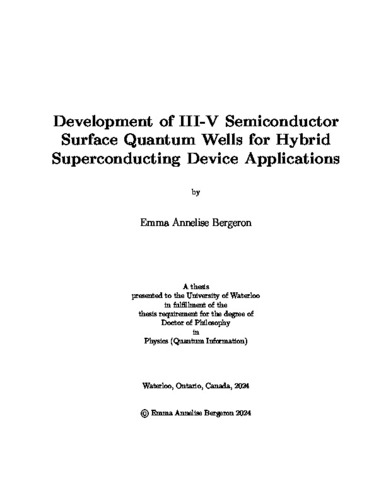| dc.description.abstract | This thesis concerns the materials development of both InSb/InAlSb and InAs/AlGaSb surface quantum wells: Two of the most promising platforms for the study of proximity-induced superconductivity in semiconductors with strong spin-orbit interaction. Our work covers the growth, fabrication, and measurement of Hall-bar and Josephson junction devices in both material systems. We optimize surface quantum well heterostructure growth by molecular beam epitaxy (MBE) for single subband occupation and no parasitic parallel conduction. Electronic transport measurements in magnetic fields were carried out on the resulting heterostructures and analyzed.
We highlight issues with the reproducibility of modulation-doped structures in InSb quantum wells and investigate the influence of doping density, buffer choice, growth parameters, and alloy composition on observed parallel conduction in the heterostructure. We show that nominally identical growths can differ by occupation of a parallel conduction channel. We also show that the window for modulation $\delta$ doping density between growths is smaller than the observed deviation in calibrated doping densities. We report on the growth, fabrication, and transport characteristics of high-quality, gate-tunable InSb two-dimensional electron gases (2DEGs) in surface quantum wells grown on (001) SI-GaAs substrates. We demonstrate the influence of modulation doping on gating characteristics, magnetotransport behavior, and spin-orbit interaction in two heterostructures, one with and one without a modulation-doped InAlSb layer. Magnetoresistance measurements confirm that intentional dopants in InSb are compatible with high-quality and reproducible transport characteristics, without parasitic parallel conduction or unstable carrier densities. This could be further tested in a 2DEG heterostructure with a short-period InSb/InAlSb superlattice doping scheme, where only the thin layer is doped.
We present the first report of a surface quantum well in the lattice-matched InAs/AlGaSb material system on GaSb substrates. Deep quantum wells in this system have demonstrated record mobilities, by an order of magnitude, over the more commonly reported InAs/InGaAs system, making it a promising platform for topological quantum computing with Majorana zero modes. The surface of the quantum well is protected by lithography techniques designed to protect the surface from unnecessary chemical exposure during fabrication. Our results show that the carrier density is greatly enhanced in a surface quantum well compared to deeper structures and is highly influenced by the choice of gate dielectric in top-gated devices, often pushing the 2DEG into the second subband. However, the gating characteristics of the 2DEG show that the device can be tuned to a single-subband occupation. Josephson junctions with ex-situ sputtered contacts to these InAs surface quantum wells are fabricated using a surface passivation technique. Our lift-off process for ex-situ sputtered Nb/Ti contacts achieves smooth edges compatible with top-gated devices. We report the observation of induced superconductivity in undoped InAs surface quantum wells using this fabrication process. Two generations of SNS samples were fabricated with ebeam lithography and surface passivation techniques. The interface transparencies of the two generations of samples were determined. We observe a dependence of the critical current on junction length, corresponding to a sensitivity to elastic scattering in the semiconductor. The temperature dependence of the critical current in the junction with arbitrary transparency is modeled by the Kulik-Omelyanchuk relation. The measured excess current, resulting from Andreev reflection processes at the normal/superconducting (SN) interfaces, confirms the presence of phase-coherent behavior in our SNS devices. The process further achieves ex-situ high-transparency superconducting contacts in league with reports of epitaxial aluminum systems to InAs surface quantum wells. | en |

